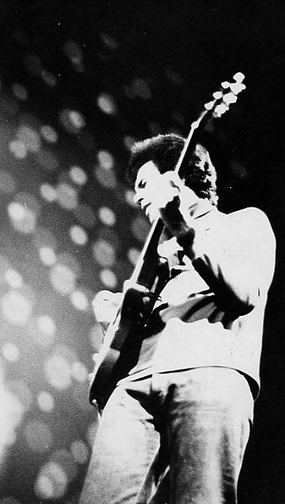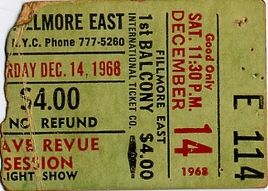ThroBak Artist Profile
ThroBak Wire: Newsletter Artist Profile, Issue 6. Scroll down for previous artist profile articles.
Eddie Martinez: The Heart of a Passionate Player
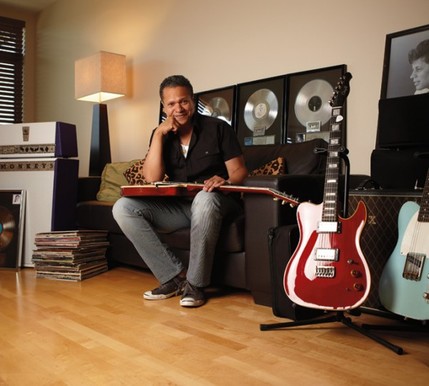
Eddie Martinez has played guitar on decades worth of hits with everyone from Labelle, Blondie, Steve Winwood, Run-D.M.C., Mick Jagger, Rod Stewart and most famously, Robert Palmer. Eddie’s flash and passionate guitar playing were the perfect foil for Robert Palmer’s controlled, suited stage presence.
Today, Eddie’s hair may be shorter and his stage clothes a little more understated, but the passion in his playing is still there. Just check out Eddie playing with Joe Bonamassa at the 1:15 minute mark of the video below
The ThroBak Wire was able to catch up to Eddie and talk about his early life, musical influences, his storied career, favorite gear and what the future holds.
Q: Eddie, where were you born?
EM: Queens, N.Y. and moved to the South Bronx at age 9.
Q: Did you come from a musical family?
EM: Not particularly, my dad played Bugle in the Army but my Mother has an intrinsically musical mind. She has a song for each of her 7 children. That said, there was always music playing in our apartment, from Eddie Palmieri, Tito Puente to Dylan, The Beatles, Hendrix, Sun Ra and Tony Bennett to name a few.
Today, Eddie’s hair may be shorter and his stage clothes a little more understated, but the passion in his playing is still there. Just check out Eddie playing with Joe Bonamassa at the 1:15 minute mark of the video below
The ThroBak Wire was able to catch up to Eddie and talk about his early life, musical influences, his storied career, favorite gear and what the future holds.
Q: Eddie, where were you born?
EM: Queens, N.Y. and moved to the South Bronx at age 9.
Q: Did you come from a musical family?
EM: Not particularly, my dad played Bugle in the Army but my Mother has an intrinsically musical mind. She has a song for each of her 7 children. That said, there was always music playing in our apartment, from Eddie Palmieri, Tito Puente to Dylan, The Beatles, Hendrix, Sun Ra and Tony Bennett to name a few.
|
|
Q: What was your earliest music memory?
EM: My earliest musical memory is probably seeing Jerry Lee Lewis on American Bandstand sing Great Balls of Fire. I recall telling Dick Clark this story when performing on his show with Lenny White and Twennynine. He laughed and said I was making him feel old. He was a real gentleman and his show was so professionally coordinated. After seeing what appeared to be huge flame come out of Jerry Lee Lewis’ piano I was hooked. He was so animated and it was swingin’. It was stark and crazy for the time which was cool. I also remember Jackie Wilson on Bandstand; he was dynamic and what an entertainer and singer! There was also another show in NY in those days called Jocko which was like a precursor to Soul Train. It was like a Black American Bandstand and it was great! Man, that’s going way back. |
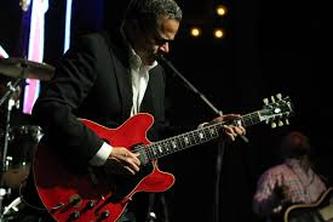
Q: What kinds of music did you listen to growing up?
EM: The Beatles was the first spark for me and Revolver was my first LP. I then went back and bought the rest of The Beatles records that preceded Revolver. I was hooked; it was so fresh and new with Gretsch and Rickenbacker guitars twanging in a different way from Surf music. Then came Hendrix with Are you Experienced ... that did it. That recording was iconoclastic; it shattered everything that happened before and reassembled it for me. It was transformative. Then came Procol Harum, Cream Disraeli Gears, Jeff Beck Group, Rolling Stones. It was such an amazing musical time.
EM: The Beatles was the first spark for me and Revolver was my first LP. I then went back and bought the rest of The Beatles records that preceded Revolver. I was hooked; it was so fresh and new with Gretsch and Rickenbacker guitars twanging in a different way from Surf music. Then came Hendrix with Are you Experienced ... that did it. That recording was iconoclastic; it shattered everything that happened before and reassembled it for me. It was transformative. Then came Procol Harum, Cream Disraeli Gears, Jeff Beck Group, Rolling Stones. It was such an amazing musical time.
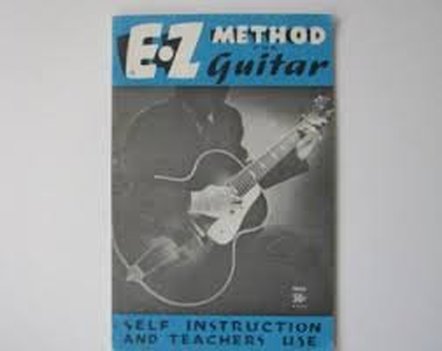
Q: Was guitar your first instrument?
EM: French Horn was my first instrument in Junior High School. It’s still my favorite horn.
Q: And did you have any musical training growing up?
EM: No, I didn’t have any musical training other than music theory in High School. We had wonderful out of the box music teachers in those days. The fundamentals they taught stayed with me. I only wished I had a piano at home to apply the theory but that would have been impossible to do in a 5 story walk up in the South Bronx in addition to the cost of a piano.
Q: What got you interested in playing guitar?
EM: The Beatles and Hendrix.
Q: Did you take guitar lessons?
EM: Not at first; I had an EZ Guitar Method book I bought and also mailed 25 cents to WABC AM Radio and they sent me a Beatle song book. I was so thrilled, that’s how I learned at first in addition to listening to records and learning riffs. I did take one lesson from John Abercrombie years later. That was very cool and he went over the modes with me on guitar. I also took a few lessons from Sal Salvador in the Brill Building years ago. Both Sal and John were absolutely great.
Q: What was your first really good guitar and amp?
EM: My first amp was a Black Panel Deluxe Reverb my dad bought in a pawn shop for me and a Gretsch Corvette. I think I waited a couple of years for that setup. I come from humble beginnings. I’m so glad my Dad saw me do some cool things before he passed. I wish I still had that amp.
EM: French Horn was my first instrument in Junior High School. It’s still my favorite horn.
Q: And did you have any musical training growing up?
EM: No, I didn’t have any musical training other than music theory in High School. We had wonderful out of the box music teachers in those days. The fundamentals they taught stayed with me. I only wished I had a piano at home to apply the theory but that would have been impossible to do in a 5 story walk up in the South Bronx in addition to the cost of a piano.
Q: What got you interested in playing guitar?
EM: The Beatles and Hendrix.
Q: Did you take guitar lessons?
EM: Not at first; I had an EZ Guitar Method book I bought and also mailed 25 cents to WABC AM Radio and they sent me a Beatle song book. I was so thrilled, that’s how I learned at first in addition to listening to records and learning riffs. I did take one lesson from John Abercrombie years later. That was very cool and he went over the modes with me on guitar. I also took a few lessons from Sal Salvador in the Brill Building years ago. Both Sal and John were absolutely great.
Q: What was your first really good guitar and amp?
EM: My first amp was a Black Panel Deluxe Reverb my dad bought in a pawn shop for me and a Gretsch Corvette. I think I waited a couple of years for that setup. I come from humble beginnings. I’m so glad my Dad saw me do some cool things before he passed. I wish I still had that amp.
 Left to right: Eddie Martinez, Jeff Bova, Bernard Edwards, Robert Hart, Tony Thompson.
Left to right: Eddie Martinez, Jeff Bova, Bernard Edwards, Robert Hart, Tony Thompson.
Q: Who were your guitar heroes growing up?
EM: Growing up it was Hendrix, Beck, Clapton, George Harrison, Albert King, Freddie King and BB King. I saw BB King at the Fillmore East several times. I dug Bloomfield as well. I saw Albert and Freddie once and wish I had seen them more frequently. Albert King was my personal favorite. Freddie King was a force of nature as well. I saw him at a club in Connecticut and the performance was so intense I thought the structural integrity of the club was being compromised!! Intense would be an understatement. Without a doubt through the years Jeff Beck is the guitarist I’ve seen the most and was privileged to play with him on Jagger’s ‘She’s the Boss’. He is very, very special in my book. He’s the goods.
Q: What type of music did you play in your first band?
EM: It was a top 40 band but we also played Hendrix, Cream and Vanilla Fudge tunes.
Q: When did you start playing professionally?
EM: I was around 15 or 16 yrs old. I would have to hide backstage in between sets.
Q: How did your studio career start?
EM: After doing tours as well as recording with Labelle, Nona Hendryx, Lenny White, Stanley Clarke & George Duke and Blondie, I wanted to make a concerted effort to have the studio session work be more consistent. I was able to connect with Bernard Edwards of Chic and he started using me on recordings. We had a great run and worked on all sorts of great records, soundtracks; most notably was Robert Palmer’s Riptide.
EM: Growing up it was Hendrix, Beck, Clapton, George Harrison, Albert King, Freddie King and BB King. I saw BB King at the Fillmore East several times. I dug Bloomfield as well. I saw Albert and Freddie once and wish I had seen them more frequently. Albert King was my personal favorite. Freddie King was a force of nature as well. I saw him at a club in Connecticut and the performance was so intense I thought the structural integrity of the club was being compromised!! Intense would be an understatement. Without a doubt through the years Jeff Beck is the guitarist I’ve seen the most and was privileged to play with him on Jagger’s ‘She’s the Boss’. He is very, very special in my book. He’s the goods.
Q: What type of music did you play in your first band?
EM: It was a top 40 band but we also played Hendrix, Cream and Vanilla Fudge tunes.
Q: When did you start playing professionally?
EM: I was around 15 or 16 yrs old. I would have to hide backstage in between sets.
Q: How did your studio career start?
EM: After doing tours as well as recording with Labelle, Nona Hendryx, Lenny White, Stanley Clarke & George Duke and Blondie, I wanted to make a concerted effort to have the studio session work be more consistent. I was able to connect with Bernard Edwards of Chic and he started using me on recordings. We had a great run and worked on all sorts of great records, soundtracks; most notably was Robert Palmer’s Riptide.
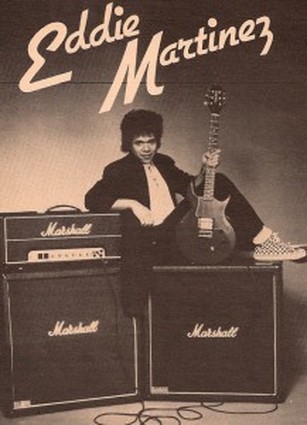 Marshall Amp trade print ad.
Marshall Amp trade print ad.
Q: You mentioned working with Bernard Edwards, one half of the Chic’s brilliant rhythm section, which also included Tony Thompson on drums. Can you describe the creative process of working with these two greats?
EM: Well, we laughed a lot and it was pure joy in the process. Bernard had the most incredible way of making records feel really good. He had a great gift of deconstructing songs and getting to the essence of what made them great. He had huge ears and an inexorable way of making a song sound and feel special. In addition, he was such a great musician and bassist. His touch and feel on the bass are unique to him. Nobody sounds like Bernard. Tony was a Monster and had a sound and feel that was totally signature and unique. He hit the drums so hard and in a way that the microphones liked. And on top of it he swung in in a very unique way. I would be remiss if I didn’t mention Jeff Bova (keys) who is an amazing keyboardist/programmer. He is preeminent at his art and a big factor on those recordings.
Q: Your other recording credits from 1985-1988 read like a who’s who of mid-80’s radio hits from Mick Jagger, Robert Palmer, David Lee Roth, Steve Winwood, Rod Stewart - what is the thing in your mind that stands out about that experience?
EM: I never thought about the credits I was accumulating at the time. I tell people its the journey that is fun especially if you love what you do. I look back at my discography now and say it was lots of fun but its not over yet either!
EM: Well, we laughed a lot and it was pure joy in the process. Bernard had the most incredible way of making records feel really good. He had a great gift of deconstructing songs and getting to the essence of what made them great. He had huge ears and an inexorable way of making a song sound and feel special. In addition, he was such a great musician and bassist. His touch and feel on the bass are unique to him. Nobody sounds like Bernard. Tony was a Monster and had a sound and feel that was totally signature and unique. He hit the drums so hard and in a way that the microphones liked. And on top of it he swung in in a very unique way. I would be remiss if I didn’t mention Jeff Bova (keys) who is an amazing keyboardist/programmer. He is preeminent at his art and a big factor on those recordings.
Q: Your other recording credits from 1985-1988 read like a who’s who of mid-80’s radio hits from Mick Jagger, Robert Palmer, David Lee Roth, Steve Winwood, Rod Stewart - what is the thing in your mind that stands out about that experience?
EM: I never thought about the credits I was accumulating at the time. I tell people its the journey that is fun especially if you love what you do. I look back at my discography now and say it was lots of fun but its not over yet either!
 Robert Palmer Ripide album 1985
Robert Palmer Ripide album 1985
Q: You are probably most associated with the guitar work you did with Robert Palmer on his album Riptide, which includes the songs Addicted to Love and Hyperactive. How did you come to work with Robert Palmer?
EM: He asked me to play after I met him at Power Station. I was recording at Power Station (The Studio) and heard Power Station (The Band) was upstairs and figured I’d say hello to Bernard and Jason Corsaro (genius recording engineer) as well as to say hi to Andy Taylor and John Taylor (Duran Duran). I got to know them when I was with Blondie and Duran Duran opened for us. I got to talking with Robert and he asked me to play on his solo record.
Q: On a personal note, I attended the Robert Palmer show at the Centre in the Square. in Kitchener, Ontario Canada on April 9, 1986. That show kicked off the North American tour. It was a great show! I especially remember “Bad Case of Loving You”.
EM: Really? That’s amazing and I remember that first show very well! It was a very intense show and I loved every minute of playing with Robert. We played hard every night with few days off. I toured with Robert on all his world tours spanning from 1986 to 1998. The experience was incredible. Robert was a true musician with an incredibly wide range of taste and style. He was a good friend and gentleman. Roberts gig covered every conceivable musical style..From Metal to Bossa Nova, Highlife, Pop, Big thick crunchy tunes to funk and R&B and then throw in an occasional Standard. The gig kept you on your toes because there were always updates to arrangements while touring. My Bradshaw system that Bob Bradshaw and John Suhr built for me at Custom Audio Electronics was essential in being able to change sounds quickly and essentially recreate the sounds on the recording. I had the entire show programmed; it made my life easy so I could focus on performance.
EM: He asked me to play after I met him at Power Station. I was recording at Power Station (The Studio) and heard Power Station (The Band) was upstairs and figured I’d say hello to Bernard and Jason Corsaro (genius recording engineer) as well as to say hi to Andy Taylor and John Taylor (Duran Duran). I got to know them when I was with Blondie and Duran Duran opened for us. I got to talking with Robert and he asked me to play on his solo record.
Q: On a personal note, I attended the Robert Palmer show at the Centre in the Square. in Kitchener, Ontario Canada on April 9, 1986. That show kicked off the North American tour. It was a great show! I especially remember “Bad Case of Loving You”.
EM: Really? That’s amazing and I remember that first show very well! It was a very intense show and I loved every minute of playing with Robert. We played hard every night with few days off. I toured with Robert on all his world tours spanning from 1986 to 1998. The experience was incredible. Robert was a true musician with an incredibly wide range of taste and style. He was a good friend and gentleman. Roberts gig covered every conceivable musical style..From Metal to Bossa Nova, Highlife, Pop, Big thick crunchy tunes to funk and R&B and then throw in an occasional Standard. The gig kept you on your toes because there were always updates to arrangements while touring. My Bradshaw system that Bob Bradshaw and John Suhr built for me at Custom Audio Electronics was essential in being able to change sounds quickly and essentially recreate the sounds on the recording. I had the entire show programmed; it made my life easy so I could focus on performance.
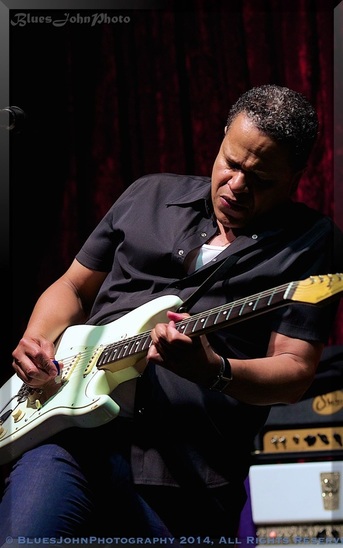
Q: You are now based in Portland, Oregon. Can you bring our readers up to speed with what you’ve been doing lately?
EM: I have my own band ‘The Eddie Martinez Band’ and play around Portland regularly. I’m planning a new recording this year which I am really looking forward to. I also have a boutique ad agency (Amped Media Solutions) that buys media, produces commercial and score music for clients.
Q: What guitars do you currently use?
A. I use guitars built by John Suhr, Bill Chapin, Saul Koll, Chad Underwood and Jack Briggs. They are all outstanding builders. I also have Fender and Gibson guitars I use as well. With these custom builders, some are Strat type guitars and some are neck set Gibson type. I also have a Gibson Historic Makeover Burst and a ’68 Gibson 335.
Q: What amps are you using?
EM: I primarily use a killer 30 watt Suhr Badger and a Fender Deluxe modded by Bill Krinard that’s great. I also have Custom Audio Electronics amps, Three Monkeys GM II and some old Mark III Boogies that Boogie restored for me.
Q: What effects do you currently use?
EM: I use a COT50 by Lovepedal, Vemuram JanRay, Dumkudo pedal, Maxxon Sonic Distortion, Wet (Reverb) Pedal, Line6 DL4 and a Vertex Fuzz pedal.
Q: What ThroBak pickups are you currently using?
EM: I use the ThroBak MC-102B set in my Historic Makeover Les Paul and a ThroBak SLE-101 set in a Flying V that Saul Koll built for me. They are great, the ThroBak MC-102B are voiced perfectly for the Historic makeover. Its made a huge difference in the sound of the guitar. It’s a cannon. The ThroBak SLE-101 in the Koll Flying V sounds just the way I heard it in my head. It pairs up so well with the Korina and rings like a V should. It screams.
Q: How would you best describe your guitar playing?
EM: I eschew being put in a box relative to style because I am a lover of all styles and genre’s of music. There are producers that I would work with that wanted my Big Guitar sound and some for my funk stuff and pop approach. Versatility is essential in the musical world I come from. That said I guess I’d be called a Rock, Blues Funk cat that throws in an occasional bop lick. In essence I try to absorb as much as I can and then forget it. The really cool stuff comes out when not thinking too much about what you’re trying to do. In a nutshell I try not to sound academic when playing.
Q: What piece of advice can you give that you’ve learned from being a successful working musician?
EM: The first would be to always give your absolute best to whatever it is you’re doing. The guitar is such an amazing instrument and there is always something new to learn. So keep seeking, keep learning and try to find your authentic self with your instrument.
Written by: Matthew Quail
ThroBak Wire: Newsletter Artist Profile, Issue 5. Scroll down for previous artist profile articles.
Jimmy Vivino: Playing Unsafe Guitar.
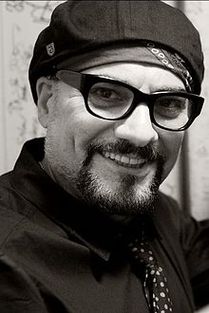
Jimmy Vivino is best known as the bandleader of Jimmy Vivino & the Basic Cable Band the house band for the Conan O'Brien show, seen weeknights at 11/10c on tbs. Jimmy has played and recorded with music legends Al Kooper, Levon Helm and Johnnie Johnson to name just a few. Vivino got his start professionally in music playing, producing and arranging for Phoebe Snow, Laura Nyro, John Sebastian and Donald Fagen. While his constant presence on late night TV for the last 22 years has given him a high visibility, Jimmy Vivino is a musician who knows how to keep things fresh by constantly stretching himself musically with his many side projects including: The Prisoners of 2nd Avenue, Rumble and Twang with Lee Rocker, the Barn Burners, the Rekooperators, and with Jimmy Vivino & the Black Italians.
Another one of Jimmy's side projects is playing guitar and keyboards in the Fab Faux, the premiere Beatles tribute band in the world that is dedicated to recreating The Beatles catalog live. The ThroBak Wire was able to sit down with Jimmy at a recent Fab Faux show in Ann Arbor at the historic Michigan Theater to talk about a life in music, musicians who have inspired him, guitars, amps and how to recreate the sound of a classic Beatles guitar riff.
Another one of Jimmy's side projects is playing guitar and keyboards in the Fab Faux, the premiere Beatles tribute band in the world that is dedicated to recreating The Beatles catalog live. The ThroBak Wire was able to sit down with Jimmy at a recent Fab Faux show in Ann Arbor at the historic Michigan Theater to talk about a life in music, musicians who have inspired him, guitars, amps and how to recreate the sound of a classic Beatles guitar riff.
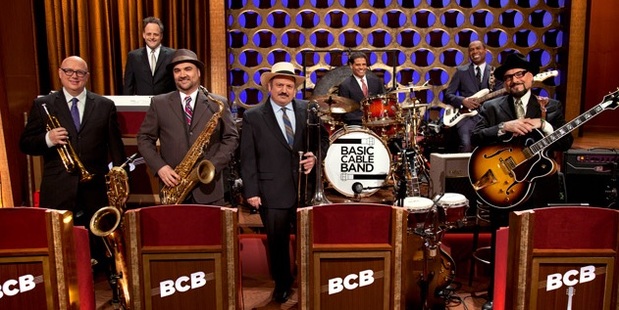
Q: Jimmy, some people may not know that guitar is not your first instrument and that you didn't pursue studying guitar until you were 23 years old. How do you think your relative late start to guitar has influenced your playing?
JV: I was a trumpet player first, reading and arranging for big band and playing piano, so I don't approach everything from a guitar point of view. Being a trumpet player and an arranger I approach guitar parts as a horn player. I'm interested in lines that go behind the singer in the rhythm than just straight ahead chunks or chords. So its thinking more from an arranger's point of view - which is a different style of comping. Comping, playing backup guitar, is something that almost got lost with all the great soloists that came up in the 1960's. Guitar players like Joe Pass, Tal Farlow and Kenny Burrell influenced the way I approached the guitar. I want to be reactive to the singer, not always with a B.B. King line, but with a sax line. The keyboard has the same sort of approach in comping - guys like Joe Zawinul with Cannonball Adderly and Horace Silver's funky piano playing influenced me on guitar.
Q: How do you see the state of guitar today?
JV: Well, there's a lot of well rounded players out there. There's a guy from Boston named Duke Levine, who plays with Peter Wolf, Rosanne Cash, Lee Ann Womack and a lot of other people, who is great. And Blake Mills, from California, is just unbelievable. He can play anything from bluegrass, to straight-up country to blues to rock 'n' roll.
I think we have a broader approach to music now with country and roots music becoming so strong in people's vocabulary. It's not just blues anymore. People are hip to Speedy West and Jimmy Bryant now because of guys like Danny Gatton that moved it forward into this psycho-billy kind of country/jazz type of playing. Because a lot of kids have these bluegrass chops the melting pot is getting even more crowded now and that not only helps the playing but also helps the song writing.
JV: I was a trumpet player first, reading and arranging for big band and playing piano, so I don't approach everything from a guitar point of view. Being a trumpet player and an arranger I approach guitar parts as a horn player. I'm interested in lines that go behind the singer in the rhythm than just straight ahead chunks or chords. So its thinking more from an arranger's point of view - which is a different style of comping. Comping, playing backup guitar, is something that almost got lost with all the great soloists that came up in the 1960's. Guitar players like Joe Pass, Tal Farlow and Kenny Burrell influenced the way I approached the guitar. I want to be reactive to the singer, not always with a B.B. King line, but with a sax line. The keyboard has the same sort of approach in comping - guys like Joe Zawinul with Cannonball Adderly and Horace Silver's funky piano playing influenced me on guitar.
Q: How do you see the state of guitar today?
JV: Well, there's a lot of well rounded players out there. There's a guy from Boston named Duke Levine, who plays with Peter Wolf, Rosanne Cash, Lee Ann Womack and a lot of other people, who is great. And Blake Mills, from California, is just unbelievable. He can play anything from bluegrass, to straight-up country to blues to rock 'n' roll.
I think we have a broader approach to music now with country and roots music becoming so strong in people's vocabulary. It's not just blues anymore. People are hip to Speedy West and Jimmy Bryant now because of guys like Danny Gatton that moved it forward into this psycho-billy kind of country/jazz type of playing. Because a lot of kids have these bluegrass chops the melting pot is getting even more crowded now and that not only helps the playing but also helps the song writing.
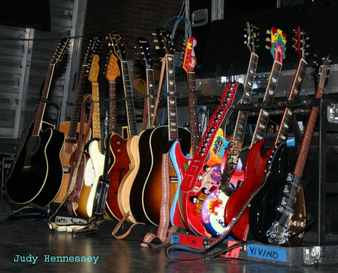 Some of Jimmy's Guitars for a Fab Faux gig!
Some of Jimmy's Guitars for a Fab Faux gig!
Q: Let me ask you about the Fab Faux. For our readers who don't know, the Fab Faux recreates The Beatles music live. There's a lot of joy happening between the band and audience during a show. Is it as much fun playing the music as it is for the audience watching and hearing it?
JV: It is as much fun playing it! When we started the Fab Faux 17 years ago it was all about doing songs that The Beatles never did. We started with the psychedelic era and moved forward and then we rewound and started digging' the early albums. And even we had a misconception that it wasn't something fantastic in its purest, earliest form - but it was. There was something special about that combination of players. They had the rhythm/lead two-guitar concept thing down. Who else could get away covering "Twist & Shout" and make it better? There will never be another band that will change music in such a short period of time. When you think that their recorded output was over just seven-and-a-half years - it's amazing!
Q: What kind of Beatles gear are you using to recreate the songs live?
JV: The Fab Faux are forensic musicologists. We're archeologists, anthropologists, everything (laughs). I've got a historic copy of George Harrison's '57 Les Paul nick-named "Lucy", made famous by Eric Clapton using it on the solo of "While My Guitar Gently Weeps", a Black '57 Gretsch Duo-Jet, a Gibson J-160E strung with flatwounds and played through an amp for the absolute sound of "I Fell Fine", a '90s Rickenbacker 325 V-59 with a Bigsby like John's, a copy of George's famous "Rocky" Fender Strat, an Epiphone Casino with newly installed SB-Special Soap Bar pickups strung with 10-49 flat wounds, plus a whole bunch more electrics and acoustics.
Q: Flat wound strings, I guess, are an important part of accurately covering a Beatles song?
JV: Yeah, because when you’re playing a riff like "Day Tripper" the note dies, it sinks. And also when you’re playing rhythm it’s tight like a Chuck Berry sound. We’re obsessed with sounds on their records.
JV: It is as much fun playing it! When we started the Fab Faux 17 years ago it was all about doing songs that The Beatles never did. We started with the psychedelic era and moved forward and then we rewound and started digging' the early albums. And even we had a misconception that it wasn't something fantastic in its purest, earliest form - but it was. There was something special about that combination of players. They had the rhythm/lead two-guitar concept thing down. Who else could get away covering "Twist & Shout" and make it better? There will never be another band that will change music in such a short period of time. When you think that their recorded output was over just seven-and-a-half years - it's amazing!
Q: What kind of Beatles gear are you using to recreate the songs live?
JV: The Fab Faux are forensic musicologists. We're archeologists, anthropologists, everything (laughs). I've got a historic copy of George Harrison's '57 Les Paul nick-named "Lucy", made famous by Eric Clapton using it on the solo of "While My Guitar Gently Weeps", a Black '57 Gretsch Duo-Jet, a Gibson J-160E strung with flatwounds and played through an amp for the absolute sound of "I Fell Fine", a '90s Rickenbacker 325 V-59 with a Bigsby like John's, a copy of George's famous "Rocky" Fender Strat, an Epiphone Casino with newly installed SB-Special Soap Bar pickups strung with 10-49 flat wounds, plus a whole bunch more electrics and acoustics.
Q: Flat wound strings, I guess, are an important part of accurately covering a Beatles song?
JV: Yeah, because when you’re playing a riff like "Day Tripper" the note dies, it sinks. And also when you’re playing rhythm it’s tight like a Chuck Berry sound. We’re obsessed with sounds on their records.
 Jimmy's 2013 release on Blind Pig Records
Jimmy's 2013 release on Blind Pig Records
Q: Your 2013 release, "13 Live" showcases your vocal abilities. Can you talk about that?
JV: I got to be a better singer from working and learning from the best. People like Laura Nyro, Felix Cavaliere. Levon Helm and Rick Danko really taught me a lot about singing. Rick maybe more than anybody. Once we were sitting on a bus rehearsing "It Makes No Difference" for a show that night and he and I are singing the line "And the sun don't shine anymore" and he stops me and says, "Don't hit the note, let the note open up like a horn." Then I realized singing is not just opening your mouth and letting the words out. Rick always had the dynamics thing. I think he was the vocal arranger for The Band. He was such a beautiful guy. But singing is hard. Thank you, I appreciate the complement, but I'm still working on it (laughs)!
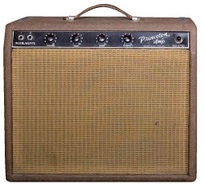 '61 brown Tolex Fender Princeton
'61 brown Tolex Fender Princeton
Q: What amps are you using right now?
JV: The minute I got to California it was like getting to Fender heaven. I got a '53 Tweed Deluxe, a '64 Blackface Vibrolux, a 4x10 Bassman. My go to amp for recording right now in a '61 brown Princeton with a 10" speaker, one tone and the greatest vibrato. On Conan I am using a wonderful Magnatone Twilighter (1x12) that is just stellar. I've also got a Longhorn Texas Tru Tone (Tweed 1x12) from Austin, Texas that is a really great amp. I use pedals on Conan, and in the Fab Faux because I am simulating record sounds in that gig, but if I am playing a blues gig or playing with Al Kooper or Lee Rocker I just plug straight into the amp - I call that playing unsafe guitar, nothing between you and the amp! I won't try a guitar in anything but a small tube amp. I use my '61 Princeton every time I test a new guitar out. It's important to have a consistent amp when trying out a guitar.
JV: The minute I got to California it was like getting to Fender heaven. I got a '53 Tweed Deluxe, a '64 Blackface Vibrolux, a 4x10 Bassman. My go to amp for recording right now in a '61 brown Princeton with a 10" speaker, one tone and the greatest vibrato. On Conan I am using a wonderful Magnatone Twilighter (1x12) that is just stellar. I've also got a Longhorn Texas Tru Tone (Tweed 1x12) from Austin, Texas that is a really great amp. I use pedals on Conan, and in the Fab Faux because I am simulating record sounds in that gig, but if I am playing a blues gig or playing with Al Kooper or Lee Rocker I just plug straight into the amp - I call that playing unsafe guitar, nothing between you and the amp! I won't try a guitar in anything but a small tube amp. I use my '61 Princeton every time I test a new guitar out. It's important to have a consistent amp when trying out a guitar.
Q: Jimmy, what have you learned as a working musician?
JV: Don't get stuck in the practice room. Get out and play with people and learn how to work. As long as you're playing and getting paid for it, don't worry what the music is. You're going to need it and use it some time. You can't just do what you want in life. At any job you do you can't just walk in and tell the boss, "I only want to do this". You have to do everything it takes to be a musician. If you want to be a virtuoso, that's different. But you can't decide to be a virtuoso and then complain you can't get any work!
Written by: Matthew Quail
JV: Don't get stuck in the practice room. Get out and play with people and learn how to work. As long as you're playing and getting paid for it, don't worry what the music is. You're going to need it and use it some time. You can't just do what you want in life. At any job you do you can't just walk in and tell the boss, "I only want to do this". You have to do everything it takes to be a musician. If you want to be a virtuoso, that's different. But you can't decide to be a virtuoso and then complain you can't get any work!
Written by: Matthew Quail
ThroBak Wire: Newsletter Artist Profile, Issue 4. Scroll down for previous artist profile articles.
Christoffer "Kid" Andersen: Conjuring up the Spirit of the Blues.
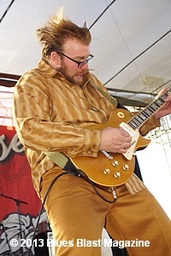 Kid Andersen tearing it up!
Kid Andersen tearing it up!
Christoffer “Kid” Andersen is one of the most versatile musicians working in Blues music today. Not only is he on a very short list of the best guitarists in the world, (look no further than the list of 2015 Blues Music Awards nominees for “Guitarist of the Year”), but he is also an accomplished producer and engineer with an ever-growing list of recording credits.
With Kid's busy tour schedule on the road and a busy studio recording schedule at home, he somehow finds the time to create informative and entertaining instructional videos that educate guitar players about his biggest pet peeve, "Stuff People Play WRONG!!!". These videos simultaneously educate the viewer/player while lowering Kid's blood pressure.
The ThroBak Wire was able to catch up with Kid as he traveled across the continental divide from Missoula, Montana to Spokane, Washington with Rick Estrin & the Nightcats to entertain yet another crowd of “real music” starved fans. Check out Kid's tour schedule with Rick Estrin & the Nightcats.
With Kid's busy tour schedule on the road and a busy studio recording schedule at home, he somehow finds the time to create informative and entertaining instructional videos that educate guitar players about his biggest pet peeve, "Stuff People Play WRONG!!!". These videos simultaneously educate the viewer/player while lowering Kid's blood pressure.
The ThroBak Wire was able to catch up with Kid as he traveled across the continental divide from Missoula, Montana to Spokane, Washington with Rick Estrin & the Nightcats to entertain yet another crowd of “real music” starved fans. Check out Kid's tour schedule with Rick Estrin & the Nightcats.
 The village of Herre, Norway in winter.
The village of Herre, Norway in winter.
Q: Chris, you were born Jan. 15, 1980 in Herre, Norway (Pop. 1,356). Can you describe a little about your childhood in Norway?
KA: Well it was pretty uneventful. There wasn’t anything on TV on the weekends until 6 pm, and in retrospect, I think that was good for getting into music and practicing. I have Viking blood running through my veins and I always longed for someplace more dangerous, so I wanted to go to America.
Q: What is your earliest musical memory?
KA: I’m not sure. Probably hearing my Grandfather playing the pipe organ in church, because I stood up and started shouting requests at him. My first memory of playing anything was fooling around on the piano and figuring out melodies by ear.
Q: What sparked your interest in the guitar?
KA: My cousin Mats was kind of the local guitar hero. At the time, around 1990, seemed like every 15 year old kid was picking up the guitar. Mats was the best one. He started teaching me, and within a few months I was beyond all the 15 year old boys and I was 11!
KA: Well it was pretty uneventful. There wasn’t anything on TV on the weekends until 6 pm, and in retrospect, I think that was good for getting into music and practicing. I have Viking blood running through my veins and I always longed for someplace more dangerous, so I wanted to go to America.
Q: What is your earliest musical memory?
KA: I’m not sure. Probably hearing my Grandfather playing the pipe organ in church, because I stood up and started shouting requests at him. My first memory of playing anything was fooling around on the piano and figuring out melodies by ear.
Q: What sparked your interest in the guitar?
KA: My cousin Mats was kind of the local guitar hero. At the time, around 1990, seemed like every 15 year old kid was picking up the guitar. Mats was the best one. He started teaching me, and within a few months I was beyond all the 15 year old boys and I was 11!
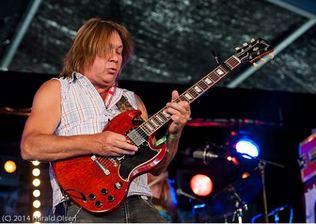 Morten Omlid, Kid Andersen's first Blues guitar mentor.
Morten Omlid, Kid Andersen's first Blues guitar mentor.
Q: Around this time you began taking lessons with Morten Omlid, a blues guitar player in the town of Notodden (about 60 miles away from Herre). He was an important mentor in your development as a player and your knowledge of music.
KA: When I came to him the only blues guitar player I knew of was Stevie Ray Vaughan. After the first lesson he gave me a stack of LP’s to take home and I put them on a cassette tape. It was T-Bone, B.B. - Live at the Regal, Albert King - Born Under a Bad Sign, Buddy Guy - Hold that Plane, Albert Collins - Ice Pickin’, collections of Howlin’ Wolf, Muddy Waters and Little Walter on Chess. That was just the first lesson. I went there every two weeks for about two years. At one point, he said “I’ve shown you everything I know”, but I still had lots to learn from him. To this day I am grateful to him, because he made me dig deep into the music from day one. If you don’t have a deep catalog of knowing the music and having those references, nothing you do will be interesting or original within the genre because you don’t know it. After my experience with Morten, I assumed everybody goes through that process. I found out they do not, and as a result, most of the stuff branded Blues today is about as interesting as raccoon vomit!
Q: Did you play locally in bands?
KA: Yes. I started my first band, which was my just me and, my friend, Daglish. His Mom got him a drum kit, so I taught myself drums so I could teach him. Later, I had a band with a high school music teacher. By the time I was 13, I was playing with much older teens and by the time I was 15 I was playing in bands with grown men.
KA: When I came to him the only blues guitar player I knew of was Stevie Ray Vaughan. After the first lesson he gave me a stack of LP’s to take home and I put them on a cassette tape. It was T-Bone, B.B. - Live at the Regal, Albert King - Born Under a Bad Sign, Buddy Guy - Hold that Plane, Albert Collins - Ice Pickin’, collections of Howlin’ Wolf, Muddy Waters and Little Walter on Chess. That was just the first lesson. I went there every two weeks for about two years. At one point, he said “I’ve shown you everything I know”, but I still had lots to learn from him. To this day I am grateful to him, because he made me dig deep into the music from day one. If you don’t have a deep catalog of knowing the music and having those references, nothing you do will be interesting or original within the genre because you don’t know it. After my experience with Morten, I assumed everybody goes through that process. I found out they do not, and as a result, most of the stuff branded Blues today is about as interesting as raccoon vomit!
Q: Did you play locally in bands?
KA: Yes. I started my first band, which was my just me and, my friend, Daglish. His Mom got him a drum kit, so I taught myself drums so I could teach him. Later, I had a band with a high school music teacher. By the time I was 13, I was playing with much older teens and by the time I was 15 I was playing in bands with grown men.
 Muddy Waters Blues Club Oslo, Norway c. 2002
Muddy Waters Blues Club Oslo, Norway c. 2002
Q: When you moved to Oslo in the late 1990’s were you now playing professionally?
KA: I wanted to, it was my reason for moving there. During my late teens I had a guitar teacher who was incredibly skilled, I guess you would call him a Jazz Fusion guy. I started thinking that with guys like that around I don’t stand a chance. So I took odd jobs to survive. But then I started meeting people in the blues and roots music scene in Oslo, namely, R.C. Finnigan and Billy Troiani, who were both Americans. I started seeing that I had a knack (and a solid foundation) in the musical world where the shredder, fusion guys were worthless. We got gigs and I quit my last day job at age 19 in 1999.
Q: An important stepping stone in your career happened when you became the guitar player in the Muddy Waters Blues Club house band in Oslo. Can you talk about that experience?
KA: I wanted to, it was my reason for moving there. During my late teens I had a guitar teacher who was incredibly skilled, I guess you would call him a Jazz Fusion guy. I started thinking that with guys like that around I don’t stand a chance. So I took odd jobs to survive. But then I started meeting people in the blues and roots music scene in Oslo, namely, R.C. Finnigan and Billy Troiani, who were both Americans. I started seeing that I had a knack (and a solid foundation) in the musical world where the shredder, fusion guys were worthless. We got gigs and I quit my last day job at age 19 in 1999.
Q: An important stepping stone in your career happened when you became the guitar player in the Muddy Waters Blues Club house band in Oslo. Can you talk about that experience?
 Willie "Big Eyes" Smith with his 2011 Grammy for best Traditional Blues album "Joined at the Hip".
Willie "Big Eyes" Smith with his 2011 Grammy for best Traditional Blues album "Joined at the Hip".
KA: That was in 1999. The club started bringing in US artists for us to back up. It was an awesome time. I played with Homesick James, Willie “Big Eyes” Smith, Jimmy Dawkins, Nappy Brown and a whole bunch of others.
Q: Were you backing these artists up for one or two nights?
KA: No. Most of them came for two weeks. Usually we would play for a week at Muddy Waters in Oslo and then the next week we would go out and do a little tour of the towns that were relatively close by. This went on for almost two years.
Q: That must have been a great learning opportunity.
KA: I got to really know the people and I learned a lot from them. Plus, I was a 19 year-old know it all.
Q: (Laughs) Were you pretty cocky?
KA: Yeah, probably, in some ways. But I always had a tremendous amount of respect for the guys that we were backing up. Plus, I already knew who these guys were from studying the music for years. The rest of the guys in the band were seasoned musicians and grown men, but they were usually looking to me because I would be the one who would know all the tunes.
Q: Were you backing these artists up for one or two nights?
KA: No. Most of them came for two weeks. Usually we would play for a week at Muddy Waters in Oslo and then the next week we would go out and do a little tour of the towns that were relatively close by. This went on for almost two years.
Q: That must have been a great learning opportunity.
KA: I got to really know the people and I learned a lot from them. Plus, I was a 19 year-old know it all.
Q: (Laughs) Were you pretty cocky?
KA: Yeah, probably, in some ways. But I always had a tremendous amount of respect for the guys that we were backing up. Plus, I already knew who these guys were from studying the music for years. The rest of the guys in the band were seasoned musicians and grown men, but they were usually looking to me because I would be the one who would know all the tunes.
 Terry Hanck
Terry Hanck
Q: You met Terry Hanck backing him up in Oslo and he asked you to move in the States and play guitar in his band in 2001. What was your impression of America then, and what did you learn working with Terry?
KA: I was always looking to a get a gig with somebody so I could move to America. Terry and I met at the right moment, as he needed a guitarist. I was 21 when I moved here and I think I felt at home pretty quickly. When we travel with the Nightcats, the joke is that I am the one in the band who acts the most like a stereotypical American. Working with Terry broadened my musical horizons a lot. I got into soul and funk music while with Terry. I had dabbled in it at home, but everything I was into when I lived in Norway I got to play, learn and experience it here tenfold. Terry spans a wide range of styles, and he’s deep. The first US touring I ever did was with Terry. I don’t think about it as a “learning experience” as much as just being my life. There is no distinction between my professional life and otherwise. When you enjoy the people you’re playing with and the music, you are enjoying life!
KA: I was always looking to a get a gig with somebody so I could move to America. Terry and I met at the right moment, as he needed a guitarist. I was 21 when I moved here and I think I felt at home pretty quickly. When we travel with the Nightcats, the joke is that I am the one in the band who acts the most like a stereotypical American. Working with Terry broadened my musical horizons a lot. I got into soul and funk music while with Terry. I had dabbled in it at home, but everything I was into when I lived in Norway I got to play, learn and experience it here tenfold. Terry spans a wide range of styles, and he’s deep. The first US touring I ever did was with Terry. I don’t think about it as a “learning experience” as much as just being my life. There is no distinction between my professional life and otherwise. When you enjoy the people you’re playing with and the music, you are enjoying life!
 Kid Andersen and Charlie Musselwhite.
Kid Andersen and Charlie Musselwhite.
Q: From Terry you went on to play and record with Charlie Musselwhite. What did you learn from Charlie?
KA: It’s not about what you “learn”, it’s about your experience together, getting to know somebody and interacting and making music. Charlie never sat me down and said, “Listen, I need a 9th chord here . . .”. Anything you learn is by symbiosis. Charlie, and a few others, but very few, can sit down with a guitar and a harp by himself and literally conjure up blues spirits from another realm. Seeing that you learn a lot, because it is something that is very difficult to do and most people can’t even recognize that it exists and feel that spirit. Charlie can do it. Paul Oscher can do it. And it has absolutely nothing to do with instrumental prowess, or sometimes, even the notes you play. It’s something intangible to strive for, that has nothing to do with gear, but everything to do with stuff you can’t see or even hear sometimes. It’s probably similar to a Buddhist becoming enlightened. It’s ultra rare and a treasure to witness.
KA: It’s not about what you “learn”, it’s about your experience together, getting to know somebody and interacting and making music. Charlie never sat me down and said, “Listen, I need a 9th chord here . . .”. Anything you learn is by symbiosis. Charlie, and a few others, but very few, can sit down with a guitar and a harp by himself and literally conjure up blues spirits from another realm. Seeing that you learn a lot, because it is something that is very difficult to do and most people can’t even recognize that it exists and feel that spirit. Charlie can do it. Paul Oscher can do it. And it has absolutely nothing to do with instrumental prowess, or sometimes, even the notes you play. It’s something intangible to strive for, that has nothing to do with gear, but everything to do with stuff you can’t see or even hear sometimes. It’s probably similar to a Buddhist becoming enlightened. It’s ultra rare and a treasure to witness.
 Rick Estrin & the Nightcats, clockwise: Rick Estrin, Kid Andersen, J. Hansen, Lorenzo Farrell.
Rick Estrin & the Nightcats, clockwise: Rick Estrin, Kid Andersen, J. Hansen, Lorenzo Farrell.
Q: You’ve been with Rick Estrin & the Nightcats since 2008. What experience have you gained from playing with Rick, J. Hansen and Lorenzo Farrell?
KA: With the Nightcats I really started learning about the real use of dynamics, poise, timing, groove and how to put on a show for people, any people, not just Blues nuts. Rick is a deep blues player and a real aficionado of all types of Black Music.
Q: What things are you working on as a producer at Greaseland, your home studio, that we can expect to see and hear in the future?
KA: I am working on a record with Little Charlie Baty and I’ve got records coming out with Wee Willie Walker and one with Ron Thompson. I probably work on 30 records or more a year.
Q: Any parting advice for the guitarist/musician out there?
KA: Whatever you gonna do, rule at it. Be the best you possibly can. “Close Enough” is not good enough. Listen to people. I don’t care if you are a sound guy, a gas station attendant or musician. There is no excuse for not kicking ass at what you do. Learn your shit as best you can!
KA: With the Nightcats I really started learning about the real use of dynamics, poise, timing, groove and how to put on a show for people, any people, not just Blues nuts. Rick is a deep blues player and a real aficionado of all types of Black Music.
Q: What things are you working on as a producer at Greaseland, your home studio, that we can expect to see and hear in the future?
KA: I am working on a record with Little Charlie Baty and I’ve got records coming out with Wee Willie Walker and one with Ron Thompson. I probably work on 30 records or more a year.
Q: Any parting advice for the guitarist/musician out there?
KA: Whatever you gonna do, rule at it. Be the best you possibly can. “Close Enough” is not good enough. Listen to people. I don’t care if you are a sound guy, a gas station attendant or musician. There is no excuse for not kicking ass at what you do. Learn your shit as best you can!
Kid Andersen's Favorite Gear
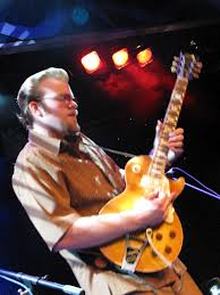
Main Guitars:
Gibson ES-345
Les Paul R8 with ThroBak PG-102 humbuckers
Gibson ES-175 with ThroBak JW-102B humbuckers
Gibson 70’s Goldtop with ThroBak ’55/’56 - SB P-90’s
Main Amps:
Fender Blackface Vibrolux, Super Reverb and Deluxe Reverb.
Fender Blackface Super Reverb.
Vintage Tweed Bassman.
Marshall Bluesbreaker Reissue.
Vintage Magnatones
’64 Vox AC30 Top Boost
Marshall Super Tremolo 100W Head
Effect Pedals:
I have 6 big shelves full of them. My main effect pedal that I use is nothing at all. I have a Line 6 M13 Stompbox Modeler that is mostly for magic tricks. If I have to play an amp I don’t like, I often use the ThroBak OD boost to push it and the Boss ’63 Reverb. But my favorite use of the ThroBak OD Boost is still as a fuzz pedal.
Favorite piece of cheap gear:
Boss ’63 Reverb Pedal. I never go anywhere without it. It’s not perfect, it’s a little brighter than a real reverb tank, but it makes damn near any amp usable.
Favorite piece of expensive gear:
Vintage Gibson guitars and Fender amps. You just can’t beat them. When I want to space out at home - my vintage Minimoog and Echoplex.
Favorite place to play:
Any place where nobody’s an asshole, people love the music, and everybody makes money. That actually narrows it down quite a bit!
Gibson ES-345
Les Paul R8 with ThroBak PG-102 humbuckers
Gibson ES-175 with ThroBak JW-102B humbuckers
Gibson 70’s Goldtop with ThroBak ’55/’56 - SB P-90’s
Main Amps:
Fender Blackface Vibrolux, Super Reverb and Deluxe Reverb.
Fender Blackface Super Reverb.
Vintage Tweed Bassman.
Marshall Bluesbreaker Reissue.
Vintage Magnatones
’64 Vox AC30 Top Boost
Marshall Super Tremolo 100W Head
Effect Pedals:
I have 6 big shelves full of them. My main effect pedal that I use is nothing at all. I have a Line 6 M13 Stompbox Modeler that is mostly for magic tricks. If I have to play an amp I don’t like, I often use the ThroBak OD boost to push it and the Boss ’63 Reverb. But my favorite use of the ThroBak OD Boost is still as a fuzz pedal.
Favorite piece of cheap gear:
Boss ’63 Reverb Pedal. I never go anywhere without it. It’s not perfect, it’s a little brighter than a real reverb tank, but it makes damn near any amp usable.
Favorite piece of expensive gear:
Vintage Gibson guitars and Fender amps. You just can’t beat them. When I want to space out at home - my vintage Minimoog and Echoplex.
Favorite place to play:
Any place where nobody’s an asshole, people love the music, and everybody makes money. That actually narrows it down quite a bit!

Kid Andersen Selected Discography:
Remembering Little Walter - Various (Engineer).
You Asked For It…Live - Rick Estrin & The Nightcats (Guitar, Producer, Mix Engineer).
Gotta Bring It On Home To You - Terry Hanck (Composer, Guitar, Acoustic Guitar, Organ, Engineer, Mixing, Mastering, Producer).
The Hustle is Really On - Mark Hummel (Engineer, Guitar).
One Wrong Turn - Rick Estrin & The Nightcats (Guitar, Bass, Keyboards, Background Vocals).
Rock Awhile - Kid Andersen (Guitar, featuring Mark Hummel, Junior Watson, Terry Hanck, Paul Ivy).
Written by: Matthew Quail
Remembering Little Walter - Various (Engineer).
You Asked For It…Live - Rick Estrin & The Nightcats (Guitar, Producer, Mix Engineer).
Gotta Bring It On Home To You - Terry Hanck (Composer, Guitar, Acoustic Guitar, Organ, Engineer, Mixing, Mastering, Producer).
The Hustle is Really On - Mark Hummel (Engineer, Guitar).
One Wrong Turn - Rick Estrin & The Nightcats (Guitar, Bass, Keyboards, Background Vocals).
Rock Awhile - Kid Andersen (Guitar, featuring Mark Hummel, Junior Watson, Terry Hanck, Paul Ivy).
Written by: Matthew Quail
ThroBak Wire: Newsletter Artist Profile, Issue 3. Scroll down for previous artist profile articles.
Matte Henderson: Veneer of Logic
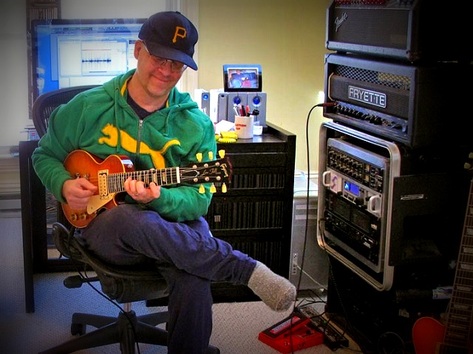
Session guitarist Matte Henderson has made a career playing for artists such as John Medeski, Tony Levin, Pat Mastelotto, Trey Gunn, Henry Kaiser and Natalie Merchant. Last year he released his first solo record “The Veneer of Logic” with help from drummer and collaborator Marco Minnemann (Joe Satriani, Steven Wilson, Aristocrats), along with contributions from David Torn, Pat Mastelotto, Trey Gunn, Mary Pastorius and Doctor Know of Bad Brains.
Currently Matte is at work on his followup to The Veneer of Logic record with Marco Minnemann, Trey Gunn and David Fiuczynski of Screaming Headless Torsos.
Possible future projects include expanding the Invisible Rays trio to a quartet, with the addition of Matte and recording in Sweden sometime in the not too distant future with Heny Kaiser, Trey Gunn, and Morgan Agren. And a possible prog. jam band with guitarists Chris Traynor and Jen Turner.
Listening to Matte’s music you understand why he is highly regarded among players in the know. Matte’s music is precise, yet multi textured, a compelling combination of complexity and simplicity. No wasted notes or words.
Recently the ThrōBak Wire was able to catch up with Matte Henderson for this interview.
Q: Who has been your biggest influence, as a guitarist and as a musician?
MH: Robert Fripp, David Torn, Alan Holdsworth, Rais Khan, l Shankar, Squarepusher, Mark Bell, Lionel Nowak, Bela Bartok, Larry Young, 1st Generation Mahavishnu Orchestra, Tony Williams Lifetime, Bad Brains, early Sabbath and Joe Zawinul.
Q: What is your favorite studio experience?
MH: Mixing my record (The Veneer of Logic) at Applehead Recording, outside Woodstock, N.Y., with Michael Birnbaum and Chris Bittner (Coheed & Cambria's production team) was extraordinary.
Currently Matte is at work on his followup to The Veneer of Logic record with Marco Minnemann, Trey Gunn and David Fiuczynski of Screaming Headless Torsos.
Possible future projects include expanding the Invisible Rays trio to a quartet, with the addition of Matte and recording in Sweden sometime in the not too distant future with Heny Kaiser, Trey Gunn, and Morgan Agren. And a possible prog. jam band with guitarists Chris Traynor and Jen Turner.
Listening to Matte’s music you understand why he is highly regarded among players in the know. Matte’s music is precise, yet multi textured, a compelling combination of complexity and simplicity. No wasted notes or words.
Recently the ThrōBak Wire was able to catch up with Matte Henderson for this interview.
Q: Who has been your biggest influence, as a guitarist and as a musician?
MH: Robert Fripp, David Torn, Alan Holdsworth, Rais Khan, l Shankar, Squarepusher, Mark Bell, Lionel Nowak, Bela Bartok, Larry Young, 1st Generation Mahavishnu Orchestra, Tony Williams Lifetime, Bad Brains, early Sabbath and Joe Zawinul.
Q: What is your favorite studio experience?
MH: Mixing my record (The Veneer of Logic) at Applehead Recording, outside Woodstock, N.Y., with Michael Birnbaum and Chris Bittner (Coheed & Cambria's production team) was extraordinary.
|
Q: ThrōBak is based in Grand Rapids, MI, the boyhood town of Anthony Kiedis, so I have to ask how you were asked to be part of the Red Hot Chili Peppers and why you turned them down?
MH: I was recommended by Vernon Reid to Anthony. Didn't seem like a good fit, personality wise. Q: What do you like about ThrōBak pickups? MH: They sit in a mix well, regardless of density and transmit nuances exceptionally well (from hyper clean to over the top gain). My Probett Rocket III and my aged Johan Gustavsson both demonstrate this exceptionally well. If my guitar has 6 strings and humbuckers it has ThrōBak pickups. |
Matte Henderson, Tomatte, The Venner of Logic.
|
Q: What advice would you give to a young guitarist just starting out?
MH: Learn your instrument inside out and don't limit yourself to a single genre. There's a huge difference between being a guitarist and a musician who plays guitar. Constantly put yourself in situations where you are musically challenged. Compose daily. Get your
production, programming and arrangement skills together. Learn to think musically without an instrument in your hands.
Matte Henderson Gear List:
Amps:
Fryette Aether
VHT Ultra Lead
Fender Red Knob Showman
Two Notes Torpedo VB-101
Guitars:
Michael Stevens 7 string LJ prototype (1996)
Johan Gustavsson Bruisemonster 7 (2003)
7 string ’59 Les Paul replica
Probett Rocket III prototype with two rod magnet ThrōBak P-90’s and a custom ThrōBak humbucker in the bridge. (2012).(This guitar was reviewed and received a Guitar Player magazine Editor’s Pick Award in the November 2014 issue.
Johan Gustavsson Bluesmaster Special with ThrōBak custom wound Alnico 5 neck & Alnico 4 Bridge pickups.
Les Paul replica with Thrōbak SLE 101 pickups.
Johan Gustavsson aged Bluesmaster ’59 Custom with custom wound ThrōBak pickups (2014).
Written by Matthew Quail.
MH: Learn your instrument inside out and don't limit yourself to a single genre. There's a huge difference between being a guitarist and a musician who plays guitar. Constantly put yourself in situations where you are musically challenged. Compose daily. Get your
production, programming and arrangement skills together. Learn to think musically without an instrument in your hands.
Matte Henderson Gear List:
Amps:
Fryette Aether
VHT Ultra Lead
Fender Red Knob Showman
Two Notes Torpedo VB-101
Guitars:
Michael Stevens 7 string LJ prototype (1996)
Johan Gustavsson Bruisemonster 7 (2003)
7 string ’59 Les Paul replica
Probett Rocket III prototype with two rod magnet ThrōBak P-90’s and a custom ThrōBak humbucker in the bridge. (2012).(This guitar was reviewed and received a Guitar Player magazine Editor’s Pick Award in the November 2014 issue.
Johan Gustavsson Bluesmaster Special with ThrōBak custom wound Alnico 5 neck & Alnico 4 Bridge pickups.
Les Paul replica with Thrōbak SLE 101 pickups.
Johan Gustavsson aged Bluesmaster ’59 Custom with custom wound ThrōBak pickups (2014).
Written by Matthew Quail.
ThroBak Wire: Newsletter Artist Profile, Issue 2. Scroll down for previous artist profile articles.
Alex Schultz: from Bank Street and Beyond.
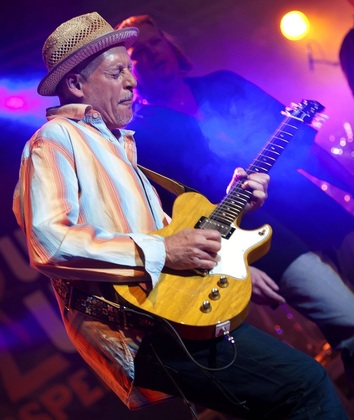
Veteran Blues guitarist and musician Alex Schultz’s musical influences began early because of parents who, in his words, were “the coolest people I knew.” Alex’s mother was a designer and his step-father was a businessman and avid jazz fan. Both parents encouraged Alex’s musical tastes from an early age in a Bank Street, Greenwich Village, NYC home that was full of "artists and avant-garde people.” When it came to blues guitar, early influences included: Michael Bloomfield, Beano era Eric Clapton, B.B. King and Jimi Hendrix. All of whom Schultz was able to see perform at NYC venues in the early stage of his development as a guitarist.
In May 1968 Schultz, then just 13 years old, was in the first row balcony at the Fillmore East when Jimi Hendrix played there for the first time. As Schultz remembers, “Jimi picked up a Les Paul Custom (with a staple P-90 neck pickup) and said, 'I’m going to play a tune called The Blues' and that was Red House. For a thirteen year old kid that was already deep into guitar that was a moment.” And in December 1968 Schultz saw Michael Bloomfield & Al Kooper Super Session open for the Sam & Dave Revue at the Fillmore East over two nights. It was a pivotal event for Schultz as Bloomfield was his greatest inspiration at that point. (A concert famous for Bloomfield's introduction of Johnny Winter to NY audiences and Columbia Records executives. Winter's performance on "It's My Own Fault" that night was captured on the record Fillmore East: The Lost Tapes 12/13/68 released in 2003).
In May 1968 Schultz, then just 13 years old, was in the first row balcony at the Fillmore East when Jimi Hendrix played there for the first time. As Schultz remembers, “Jimi picked up a Les Paul Custom (with a staple P-90 neck pickup) and said, 'I’m going to play a tune called The Blues' and that was Red House. For a thirteen year old kid that was already deep into guitar that was a moment.” And in December 1968 Schultz saw Michael Bloomfield & Al Kooper Super Session open for the Sam & Dave Revue at the Fillmore East over two nights. It was a pivotal event for Schultz as Bloomfield was his greatest inspiration at that point. (A concert famous for Bloomfield's introduction of Johnny Winter to NY audiences and Columbia Records executives. Winter's performance on "It's My Own Fault" that night was captured on the record Fillmore East: The Lost Tapes 12/13/68 released in 2003).
Inspired by Hendrix’s improvisational skills, but turned on to the sounds of blues and jazz Schultz attended Boston’s Berklee School of Music and then switched to bass guitar, because in his words, there were “a million guitarists in the city.” In 1979 he made the move to L.A. and became the bass player and then guitarist for Hank Ballard and the Midnighters. Schultz took the same route with William Clarke starting out playing bass before switching to guitar. In 1988 Schultz took over the guitar chair with Rod Piazza and the Mighty Flyers vacated by Junior Watson. Since leaving Piazza in the mid-nineties Schultz has freelanced with a variety of artists from Lester Butler, Tad Robinson, Raphael Wressnig and others.
|
Q: What projects are you currently working on?
AS: My current release is supporting Hammond B3 player Raphael Wressnig (from Austria) on his new record Soul Gumbo. We cut this record in January 2014 in New Orleans. I played guitar on the entire record (using a ’61 Gibson ES-335 with original PAF’s) with drummer Stanton Moore and Raphael as the core band. A lot of guests, including Walter “Wolfman” Washington, George Porter, Jr., & Jon Cleary, sax player Craig Handy, Larry Garner, and trumpeter Eric Bloom. Q: How did you come to be based in Europe for the last 15 years or so? |
|
Click to set custom HTML
AS: Excellent question. Simple answer: a woman- now a 8 and half year old son. I was touring steadily over in Europe since spring, 1988 (Rod Piazza & The Mighty Flyers). Always amazing support over here for blues, jazz, American Roots Music. After the Flyers trips, I came over 4 times in the late 90s with Lester Butler. Then did 4 years in a row with a great Italian band (some of whom ended up on my "Think About It" disc). During the last of those tours, (in Nov. 2001), I met a schoolteacher in the south of Germany... married in 2005 and my son was born in 2006. I stayed based here, but have kept my house in L.A. and we spend summers on the east coast USA - so I've really go the best of both worlds.
Q: Can you describe the Blues music scene in Europe?
AS: If you go back to the early '50s you see how great the Europeans supported jazz, and then by the early '60s blues as well. Black American music really received serious attention, support and respect in Europe. The musicians were amazed by it; hence so many American jazz musicians began making there lives over here. By the late '80s and early '90s blues was really on fire over here, they were also very accepting of "West Coast" style blues, mixed with some swing Rhythm & Blues. The audiences in Europe are very attentive and knowledgeable. In the '90s I was amazed that people would know every disc I'd played on. Europeans recognize music as "art" and they treat musicians very well (there isn't any such thing as a gig without a proper warm meal provided in Europe- whatever the gig! Also I feel that they are recognizing these art forms for what they are: Intrinsically American - more specifically, Black American music. This is something the USA gave to the world - Blues, Jazz, Soul, Rhythm & Blues. Of course Country music too. There are now a lot of great players in Europe; there have always been great jazz players, from Django onwards - you have an outstanding example in the ThroBak family with Kid Andersen. Anyhow the audiences and hospitality, food, beer and wine are wonderful. There is a great film on the subject called "Jazz In Exile". Your readers should check that one out!
Q: You’ve played on dozens of recordings, including William Clarke’s four Alligator releases to sessions with Rod Piazza, Lester Butler, Tad Robinson and your own record. Can you tell us about a favorite studio experience?
Q: Can you describe the Blues music scene in Europe?
AS: If you go back to the early '50s you see how great the Europeans supported jazz, and then by the early '60s blues as well. Black American music really received serious attention, support and respect in Europe. The musicians were amazed by it; hence so many American jazz musicians began making there lives over here. By the late '80s and early '90s blues was really on fire over here, they were also very accepting of "West Coast" style blues, mixed with some swing Rhythm & Blues. The audiences in Europe are very attentive and knowledgeable. In the '90s I was amazed that people would know every disc I'd played on. Europeans recognize music as "art" and they treat musicians very well (there isn't any such thing as a gig without a proper warm meal provided in Europe- whatever the gig! Also I feel that they are recognizing these art forms for what they are: Intrinsically American - more specifically, Black American music. This is something the USA gave to the world - Blues, Jazz, Soul, Rhythm & Blues. Of course Country music too. There are now a lot of great players in Europe; there have always been great jazz players, from Django onwards - you have an outstanding example in the ThroBak family with Kid Andersen. Anyhow the audiences and hospitality, food, beer and wine are wonderful. There is a great film on the subject called "Jazz In Exile". Your readers should check that one out!
Q: You’ve played on dozens of recordings, including William Clarke’s four Alligator releases to sessions with Rod Piazza, Lester Butler, Tad Robinson and your own record. Can you tell us about a favorite studio experience?
 Backstage at Peer BRBF Fest, July 1994 with Danny Gatton
"..he's holding my guitar and I his-" A. Schultz
Backstage at Peer BRBF Fest, July 1994 with Danny Gatton
"..he's holding my guitar and I his-" A. Schultz
AS: Wow, I've had some good ones! This past January, being in the studio in New Orleans and watching Jon Clearly cut his track with us live, playing a vintage Wurlitzer with one hand, a Grand Piano with another and cutting his vocal live.. real talent.
Cutting my one and only disc under my own name "Think About It"- Severn Records- again, cutting live with the late, great Finis Tasby and Tad Robinson. And recording with the late Mickey Champion, Steve Samuels, Lynwood Slim, William Clarke, being on tracks with Etta James, Lou Ann Barton, Otis Clay, Smokey Wilson, and many more whom I'm forgetting at the moment.
Q: How about a favorite live moment?
AS: Playing with Rod Piazza & The Mighty Flyers at the 1994 PEER Belgium Rhythm & Blues Festival. Danny Gatton played directly before us. I played the gig on my '51 Gretsch Synchromatic with Dynasonic pickups. I broke my high-E string early in the set, tuned, and played the whole show on 5 strings... Danny Gatton was impressed! Then directly after us: B.B. King and band (he was on fire that night, Robert Jr. Lockwood was directly in front watching the whole gig, as was I) followed by Al Green. Never have topped that gig.
Cutting my one and only disc under my own name "Think About It"- Severn Records- again, cutting live with the late, great Finis Tasby and Tad Robinson. And recording with the late Mickey Champion, Steve Samuels, Lynwood Slim, William Clarke, being on tracks with Etta James, Lou Ann Barton, Otis Clay, Smokey Wilson, and many more whom I'm forgetting at the moment.
Q: How about a favorite live moment?
AS: Playing with Rod Piazza & The Mighty Flyers at the 1994 PEER Belgium Rhythm & Blues Festival. Danny Gatton played directly before us. I played the gig on my '51 Gretsch Synchromatic with Dynasonic pickups. I broke my high-E string early in the set, tuned, and played the whole show on 5 strings... Danny Gatton was impressed! Then directly after us: B.B. King and band (he was on fire that night, Robert Jr. Lockwood was directly in front watching the whole gig, as was I) followed by Al Green. Never have topped that gig.
Q: How did you learn about ThroBak pickup and what do you like about them?
AS: I began as a Gibson guy, I had a '68 ES-335 that was my first GREAT guitar and always considered that "home". But as times change, we wander... traded that guitar away, with some cash and a reissue Strat and acquired a real '61 dot neck ES-335 w/ PAF's, at least 25 years ago. Funnily enough I never bonded that strongly with that guitar and it didn't get used all that much - though that is the resurrected guitar now heard on that Soul Gumbo disc. For many years I specialized in playing hollowbodies w/ P-90s . I have some very cool old Gibsons; and I can honestly say I was one of the first guys to really play out regularly with a vintage ES-330. I got to a point where I thought I didn't like humbuckers, and I certainly never really bonded with Les Pauls. Something started to shift in the last 10 years, I think I heard some good ones. Along the way I'd bought numerous Gibson Historics, but always sold them. 335s, Les Pauls, they seemed kind of dead to me. I did acquire a very special 2003 Gibson Historic Tom Murphy aged "Vintage World" '58 (Plaintop) LP from a run of just 30. These are now kind of "legendary" as such things go... good guitar. But it had the early "Burst Buckers” in it, I think, and though it felt and looked amazing, it never really moved me... but luckily I kept it. Somewhere along the line, I heard some really GOOD Les Pauls, and also (I should add) Michael Bloomfield was always perhaps, along with Jimi, one of my greatest inspirations. Bloomfield's LP tones were a kind of benchmark for me. In my "genre", Hollywood Fats was another guy who showed that Humbuckers could be great. But Bloomers, he used 'buckers in a clean sort of way, and I loved that. So a few things began to coalesce, and I was finding myself on the Les Paul Forum and The Gear Page and started to get real interested in ThroBak pickups. Meantime, I made a big jump and contacted Swedish luthier Johan Gustavsson. I had him make me an all Korina guitar he called a
AS: I began as a Gibson guy, I had a '68 ES-335 that was my first GREAT guitar and always considered that "home". But as times change, we wander... traded that guitar away, with some cash and a reissue Strat and acquired a real '61 dot neck ES-335 w/ PAF's, at least 25 years ago. Funnily enough I never bonded that strongly with that guitar and it didn't get used all that much - though that is the resurrected guitar now heard on that Soul Gumbo disc. For many years I specialized in playing hollowbodies w/ P-90s . I have some very cool old Gibsons; and I can honestly say I was one of the first guys to really play out regularly with a vintage ES-330. I got to a point where I thought I didn't like humbuckers, and I certainly never really bonded with Les Pauls. Something started to shift in the last 10 years, I think I heard some good ones. Along the way I'd bought numerous Gibson Historics, but always sold them. 335s, Les Pauls, they seemed kind of dead to me. I did acquire a very special 2003 Gibson Historic Tom Murphy aged "Vintage World" '58 (Plaintop) LP from a run of just 30. These are now kind of "legendary" as such things go... good guitar. But it had the early "Burst Buckers” in it, I think, and though it felt and looked amazing, it never really moved me... but luckily I kept it. Somewhere along the line, I heard some really GOOD Les Pauls, and also (I should add) Michael Bloomfield was always perhaps, along with Jimi, one of my greatest inspirations. Bloomfield's LP tones were a kind of benchmark for me. In my "genre", Hollywood Fats was another guy who showed that Humbuckers could be great. But Bloomers, he used 'buckers in a clean sort of way, and I loved that. So a few things began to coalesce, and I was finding myself on the Les Paul Forum and The Gear Page and started to get real interested in ThroBak pickups. Meantime, I made a big jump and contacted Swedish luthier Johan Gustavsson. I had him make me an all Korina guitar he called a
|
Futuremaster, and he listened to some of my music (dug it!) and recommended that he contact Jon Gundry at ThroBak for a special set. They chose the DT-102s and I got the guitar. Mind you it was probably my first serious two-humbucker solidbody in a long, long time. I was skeptical if it would really work for my wants and needs. I started taking the guitar out, and it sounded INCREDIBLE. I knew the pickups were contributing a lot, because I could get all the clarity, brightness, even 'jangle' that I might want, and then of course the 'creamy' warm smooth sustaining breakup, the singing qualities, actually all the things one ever WANTED out of a Humbucker, but didn't necessarily get! Certainly not ANY new build. I should also add, and back-step - about 4 years - I decided to buy myself a BIG birthday present, and fulfill a dream- I bought a cherry ES 335 from very early 1965, with a Bigsby. This had a dream neck on it (fuller than my '61 but still with a wide nut and just had everything going.
|
Alex Schultz playing ThroBak DT-102 pickups in his JG Futuremaster.
|
To my surprise, I thought it sounded even BETTER than my PAF '61. I'd also been playing a '64 Epiphone Riviera with Mini Humbuckers a lot, and loving that. SO I had some sounds in my ears... anyhow that set of the DT-102s had me convinced right away that all the stuff I'd been reading was not hype - and I had no reason to stick to that, I was fully prepared to say "nah ..." But the more I played that guitar out, I had people come up to me literally EVERY night, saying wow that guitar sounds great. So I knew the pickups were "real". The proof is in the pudding- on the Bandstand is the test for ANY piece of gear. You basically know right away if something is going to work or not. I've been gigging for 30+ years... these pickups simply sounded great, very expressive, I really GOT OFF playing them.
|
I then wrote Jon, asked him what he'd recommend for that "Vintage World Murphy" L.P. and he suggested I try the SLE-101 Plus MXV set. I was worried they'd be too 'hot', but he assured me to try them. MAN I might have liked them even more! Really dynamic. There it was easy to tell, because that guitar had been like something with potential but mostly a big sack of potatoes for me before. I got it set up right with those pickups, and the guitar SINGS. Like it should. Totally different instrument. This instrument came to life with those pickups, it is now a fantastic instrument.
Q: You’ve been noted for your tasteful, understated style of lead playing - how do you know when to hold back? - or is it a case of always leaving them wanting a little more? |
Alex Schultz with SLE-101 Plus equipped Les Paul.
|
AS: First I'll say thanks for that- I think that's a nice thing to be noted for. I believe every player plays somewhat to their personality, and also just 'plays it the way they hear it'.
I don't like to hear a lot of nonsense, which is unfortunately exactly what a lot of guitar players play. I try to play phrases that make sense. As to 'how to know when to hold back' it' comes down to LISTENING. More like a jazz concept. Sometimes I play in such a way that I step out of my own body, and listen to the band as if I'm listening to a mix, and then think "what do I want to hear the guitar do?" What SHOULD the guitar be doing?
I also see the guitar as a part of the rhythm section. The Groove is king for me. That is job #1. If there is a singer - and hopefully a GOOD singer - then that is also job #1. Make that singer sound great. Help him/her tell the story. Listen to their phrasing, embellish, make everything feel groovy... so they can really SING. Equally, it's supporting the ensemble.
Too much "Blues" got slung out there where some poor sap sings a chorus, rushes to get out of the way so the guitar player can take 6 choruses... I realized early on, that's not really what Blues was about for me. I dig the feeling of the totality of a B.B. King record, where he tells a story, THEN gives you some very tasty guitar, and then concludes the story. Or Muddy, or Sonny Boy - they are telling STORIES. The solo is just one part of that. Don't forget what it's all about! Shorter answer: I dug the way B.B. did it, and then Jimmie Vaughan just slayed me. I love his laid back style, but with TOTAL power. It's all about the TIMING.
As a player you have to identify, and then be comfortable with your own strengths and weaknesses. I discovered that I had something going on... but I knew it wasn't 'blazing chops' - I'm not the guy to blow you out of the water with that, or to hit you over the head...but I could pull off the FEEL and the TIMING... so I work with that, I play with that, I USE that to my advantage. Also I developed my Harmonic Knowledge - I like a little sophistication, so I use that, too - like a very aromatic spice…
OK off my soapbox now. Use your ears, listen to the other players, find the space, make it FEEL good!
And oh yes- have good tone!
Q: What piece of advice can you give a young musician just starting out or an old one still at it?
AS: Wow great question. I would say stay focused on the joy and love that the instrument gave you right from the start. I've been playing now for 50 years, and I love that I still get the same spark I had when I was 15. That's my inspiration, at the end of the day - to make it feel good to myself! I've found if I stay true to that, people seem to dig it!
I don't like to hear a lot of nonsense, which is unfortunately exactly what a lot of guitar players play. I try to play phrases that make sense. As to 'how to know when to hold back' it' comes down to LISTENING. More like a jazz concept. Sometimes I play in such a way that I step out of my own body, and listen to the band as if I'm listening to a mix, and then think "what do I want to hear the guitar do?" What SHOULD the guitar be doing?
I also see the guitar as a part of the rhythm section. The Groove is king for me. That is job #1. If there is a singer - and hopefully a GOOD singer - then that is also job #1. Make that singer sound great. Help him/her tell the story. Listen to their phrasing, embellish, make everything feel groovy... so they can really SING. Equally, it's supporting the ensemble.
Too much "Blues" got slung out there where some poor sap sings a chorus, rushes to get out of the way so the guitar player can take 6 choruses... I realized early on, that's not really what Blues was about for me. I dig the feeling of the totality of a B.B. King record, where he tells a story, THEN gives you some very tasty guitar, and then concludes the story. Or Muddy, or Sonny Boy - they are telling STORIES. The solo is just one part of that. Don't forget what it's all about! Shorter answer: I dug the way B.B. did it, and then Jimmie Vaughan just slayed me. I love his laid back style, but with TOTAL power. It's all about the TIMING.
As a player you have to identify, and then be comfortable with your own strengths and weaknesses. I discovered that I had something going on... but I knew it wasn't 'blazing chops' - I'm not the guy to blow you out of the water with that, or to hit you over the head...but I could pull off the FEEL and the TIMING... so I work with that, I play with that, I USE that to my advantage. Also I developed my Harmonic Knowledge - I like a little sophistication, so I use that, too - like a very aromatic spice…
OK off my soapbox now. Use your ears, listen to the other players, find the space, make it FEEL good!
And oh yes- have good tone!
Q: What piece of advice can you give a young musician just starting out or an old one still at it?
AS: Wow great question. I would say stay focused on the joy and love that the instrument gave you right from the start. I've been playing now for 50 years, and I love that I still get the same spark I had when I was 15. That's my inspiration, at the end of the day - to make it feel good to myself! I've found if I stay true to that, people seem to dig it!
Alex Schultz Gear List:
Amps:
Tweed Tube King (Made by Jack Van Leuwen in the Netherlands)
Bandmaster 3 x 10
Bassman 4 x 10
Carr Sportsman
Carol-Ann Texas 50
Go to studio amp:
Blackface Fender Princeton Reverb
Guitars:
1961 ES-335 original PAF’s
Johan Gustavsson Futuremaster built with ThroBak DT-102s.
2003 Gibson Historic ’58 “Vintage World” Tom Murphy loaded with ThroBak SLE-101 Plus MXV pickups.
1964 Epiphone Riviera with mini-humbuckers
1951 Gretsch Synchromatic with Dynasonic pickups
Written by Matthew Quail.
Amps:
Tweed Tube King (Made by Jack Van Leuwen in the Netherlands)
Bandmaster 3 x 10
Bassman 4 x 10
Carr Sportsman
Carol-Ann Texas 50
Go to studio amp:
Blackface Fender Princeton Reverb
Guitars:
1961 ES-335 original PAF’s
Johan Gustavsson Futuremaster built with ThroBak DT-102s.
2003 Gibson Historic ’58 “Vintage World” Tom Murphy loaded with ThroBak SLE-101 Plus MXV pickups.
1964 Epiphone Riviera with mini-humbuckers
1951 Gretsch Synchromatic with Dynasonic pickups
Written by Matthew Quail.
ThroBak Wire: Newsletter Artist Profile, Issue 1.
Rob McNelley on guitars, amps and making it in Nashville.

Nashville studio ace and ThroBak Artist, Rob McNelley, recently took some time out from his busy schedule to talk with us about guitars, amps and the upcoming Bob Seger “Ride Out” tour as lead guitarist for Bob’s Silver Bullet band. Rob’s own guitar playing influences include Keith Richards, B.B. King and Ry Cooder. After learning the Beatles and Rolling Stones songbooks Rob cut his teeth playing clubs in his hometown of Columbus, Ohio and then took the next step to Nashville where he found work backing up Tinsley Ellis, Lee Ann Womack and Delbert McClinton. When Delbert’s touring schedule began slowing Rob’s Nashville studio work started to picking up. A partial lists of his recording credits include: Lady Antebellum, Rascal Flatts, Kellie Pickler, Joe Louis Walker, Buddy Guy, James Cotton and Bob Seger. Rob’s A-list Nashville status was acknowledged this past September when he was named the Academy of Country Music Guitar Player of the Year. Rob will hit the road when Bob Seger’s “Ride Out” tour kicks off in Saginaw, Michigan on November 19th.
Q: Is the Silver Bullet Band ready to go for the first show?
RMC: We are in rehearsals for the upcoming tour. We've been doing some TV promotion for Bob's record called "Ride Out", so the band’s muscle is flexed, but we need to play through the songs for the tour for a couple of weeks.
Q: Do you have favorite song to play in Bob’s set?
RMC: “Like a Rock”.
Q: Is the Silver Bullet Band ready to go for the first show?
RMC: We are in rehearsals for the upcoming tour. We've been doing some TV promotion for Bob's record called "Ride Out", so the band’s muscle is flexed, but we need to play through the songs for the tour for a couple of weeks.
Q: Do you have favorite song to play in Bob’s set?
RMC: “Like a Rock”.
Q: That’s a great song! What gear do you use to pull off the now classic slide solo?
RMC: On the last Seger tour, I used one of Bob's guitars for "Like A Rock". It was an old Gibson Explorer. I'm not sure of the year of the guitar but it just sounded fantastic for that song. We did the song in F sharp, so it was tuned to standard tuning but down a half step. When I was learning the song, I assumed it was played in an open tuning for the slide solos. After a couple quick listens, I figured out that it was done in standard tuning. Some of the moves in those solos just wouldn't work very fluidly in open G tuning. Once I figured that out, it all made a lot more sense. I believe the Explorer had 12's on it. I just used a Dunlop Blues slide. The model that is shaped like a bottle.
Q: Have you ever had the chance to play “Like a Rock” with Rick Vito guesting? (ed. Rick Vito recorded on the 1986 studio version).
RMC: I never played that song with Rick Vito. That would've been cool.
RMC: On the last Seger tour, I used one of Bob's guitars for "Like A Rock". It was an old Gibson Explorer. I'm not sure of the year of the guitar but it just sounded fantastic for that song. We did the song in F sharp, so it was tuned to standard tuning but down a half step. When I was learning the song, I assumed it was played in an open tuning for the slide solos. After a couple quick listens, I figured out that it was done in standard tuning. Some of the moves in those solos just wouldn't work very fluidly in open G tuning. Once I figured that out, it all made a lot more sense. I believe the Explorer had 12's on it. I just used a Dunlop Blues slide. The model that is shaped like a bottle.
Q: Have you ever had the chance to play “Like a Rock” with Rick Vito guesting? (ed. Rick Vito recorded on the 1986 studio version).
RMC: I never played that song with Rick Vito. That would've been cool.
Q: What do you like best about playing live with a band? And do you have a favorite live experience?
RMC: The best thing about playing live with a band is the immediacy of being in the moment with the other musicians. Being put on the spot to perform a song. In the studio, you can fix anything you want if there's a mistake. In a live show, it's all about getting it now. And if you do make a mistake, it's all about the recovery. Plus, there's an energy going around the room that everyone involved is feeding off of. You keep putting it out to the audience and they give it back to you. It's a very special thing. I've had so many great live experiences. It would be hard to pick a favorite.
Q: What do you like best about recording in a studio?
RMC: The best thing about doing a recording session is creating something new. That's the place where you're coming up with something that wasn't there before. Taking a song to a new level with a musical hook or a great part that fits in with everything else. It's very rewarding when you get the chance to be creative in a way that touches other people. Again, being one sum of the many parts that are all working together to make something great.
Q: Do you have a favorite studio experience?
RMC: Two favorite studio experiences come to mind. Working with Tom Dowd. His energy was so positive. When he came into the room everything changed and got better. He had the magic. Very inspirational person. The other one that came to mind was recording Lady Antebellum's song "Need You Now". I remember leaving the studio and knowing I had just played on a song that was going to be a huge hit. And I was very proud of what I had played on that song. It was just one of those days where everything lined up and it was undeniable to everyone in the room. We all felt that way about it. Then it went on to win the Grammy for song of the year. It's rare that you get to play on one of those kind of songs anymore.
Q: Let’s talk about the ThroBak guitar effect pedals that you are currently using, the ThroBak Overdrive Boost and the ThroBak Stone Bender. Let’s start with the Overdrive Boost, what do you like about this pedal?
RMC: My favorite thing about the Throbak Overdrive Boost is how open it sounds. It gives every note some muscle without taking anything away from your tone. And it's completely interactive with your touch and controls on your guitar. And it will save your ass when you have to play through a not so great sounding amp!
Q: How about the ThroBak Stone Bender?
RMC: What I love most about the Stone Bender is how close it nails the Jeff Beck “Truth” tones. It's late 60's british blues rock supreme! I just used it on my forthcoming record "The New RMC" on a track called "Painting a Picture". In the middle of this song, it gets very psychedelic, and the Stone Bender nailed what I was after perfectly.
Q: Do you have a favorite guitar/amp setup if you are just playing for yourself?
RMC: Actually, I am lucky in that, I have a lot of stellar guitars and amps. I'm like a kid in a candy store when I go into my music room! My day almost always ends with about an hour or two of musical wind down. After a full day in a studio, after the family goes to bed, I like to plug something into a small amp, (Supro, Ampeg, Pro Junior, Princeton Reverb, whatever) and just find something musical. Lately, I've been playing my '58 Gibson Les Paul special. But it really doesn't matter to me which guitar or amp. It's just about playing music.
Q: What is the one thing you have learned in your career that you could pass along to other players?
RMC: The biggest thing I've learned is that it all comes down to are you in this for the right reasons or not. You are going to take a lot of beatings in this business. Your love for making music has to be stronger than the people or situations that beat you down. You have to be good at reacting to those people and situations. You have to be a great improvisor, both musically and in a business sense. Nothing in this business is set in stone. Once you're ok with that, you might have a shot.
Rob McNelley’s own record “The New RMC” will be released in early 2015.
Rob McNelley’s gear list:
Amps:
’64 Bassman head
’72 Marshall head
Matchless DC-30
Analog Outfitters “The Sarge”
Late 50’s Tweed Tremolux
Guitars:
’59 Mono ES-355
’53 Goldtop
’65 Strat - original p/u’s
’55 Tele - original p/u’s
Jeff Senn “Pomona”
’58 Gibson Les Paul Historic (2002)
ThroBak Effect Pedals:
Stone Bender - hear it on ”Painting a Picture” on Rob’s forthcoming record “The New RMC”
Overdrive Boost - hear it on Lady Antebellum’s “Hey Bartender” guitar solo
Written by Matthew Quail.




